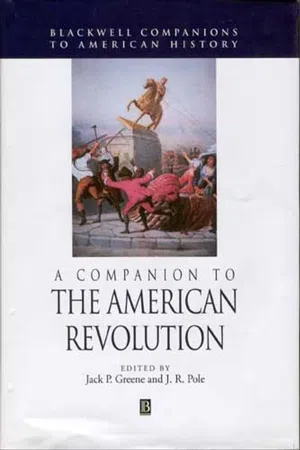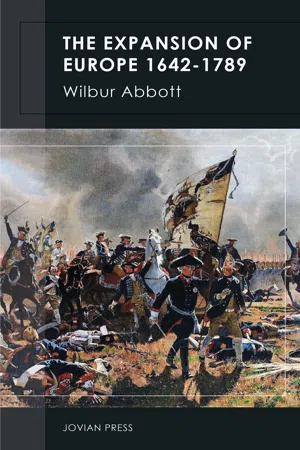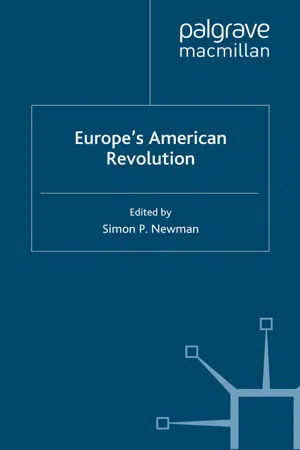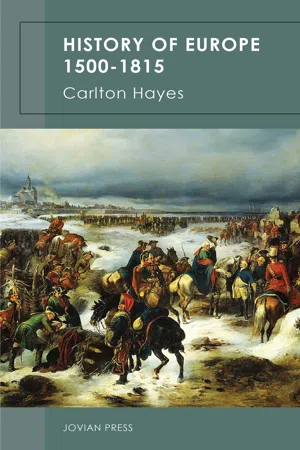History
The American Revolution
The American Revolution was a pivotal period in the late 18th century when the thirteen American colonies sought independence from British rule. It was marked by significant events such as the Boston Tea Party, the signing of the Declaration of Independence, and the military conflicts that ultimately led to the formation of the United States of America as a sovereign nation.
Written by Perlego with AI-assistance
Related key terms
1 of 5
8 Key excerpts on "The American Revolution"
- eBook - PDF
The Revolution Is Now Begun
The Radical Committees of Philadelphia, 1765-1776
- Richard Alan Ryerson(Author)
- 2012(Publication Date)
- University of Pennsylvania Press(Publisher)
254 REVOLUTION AND ORIGIN OF MODERN AMERICAN POLITICS lution worked in America. One student of comparative revolutionary phenomena has proposed a simple yet comprehensive definition of revolution, against which one may measure the American event. Eugene Kamenka has written: Revolution is a sharp, sudden change in the social location of political power, expressing itself in the radical transformation of the process of government, of the official foundations of sovereignty or legitimacy and of the conception of the social order. 15 A comparison of this convenient formula with both the extended argument pre-sented in the foregoing chapters and recent work done on the Revolution by several scholars suggests that the years 1765-76 saw a genuine revolution in Pennsylvania. Taking Mr. Kamenka's points in a somewhat different order, two of the most persuasive studies of the Revolution to appear in the last decade argue that Americans effected a radical transformation . . . of the official foundations of sovereignty in their Revolution. 16 Second, it is a major part of the argument in every chapter of this study, and of this concluding essay, thai; Pennsylvania experi-enced a radical transformation of the process of government in the decade before Independence. Closely related to changes in both political sovereignty and political process is another fundamental political alteration with which The American Revolution is often not credited, a sharp, sudden change in the social location of political power. Much recent scholarship, however, has effectively challenged the long-presumed lack of change in the social locus of political power in Revolutionary America. 17 There appears to be no basis for doubting the occurrence of this altera-tion in Pennsylvania. - No longer available |Learn more
- (Author)
- 2014(Publication Date)
- Orange Apple(Publisher)
The American shift to liberal republicanism, and the gradually increasing democracy, caused an upheaval of traditional social hierarchy and gave birth to the ethic that has formed a core of political values in the United States. ________________________ WORLD TECHNOLOGIES ________________________ Origins Before the Revolution: The Thirteen Colonies are in pink The American Revolution was predicated by a number of ideas and events that, combined, led to a political and social separation of colonial possessions from the home nation and a coalescing of those former individual colonies into an independent nation. Summary The American Revolutionary era began in 1763, after a series of victories by British forces at the conclusion of the French and Indian War ended the French military threat to British North American colonies. Adopting the policy that the colonies should pay an increased proportion of the costs associated with keeping them in the Empire, Britain imposed a series of direct taxes followed by other laws intended to demonstrate British authority, all of which proved extremely unpopular in America. Because the colonies lacked elected representation in the governing British Parliament, many colonists considered the laws to be illegitimate and a violation of their rights as Englishmen. In 1772, groups of colonists began to create Committees of Correspondence , which would lead to their own Provincial Congresses in most of the colonies. In the course of two years, the Provincial Congresses or their equivalents rejected the Parliament and effectively replaced the British ruling apparatus in the former colonies, culminating in 1774 with the coordinating First Continental Congress. In response to protests in Boston over Parliament's attempts to assert authority, the British sent combat troops, dissolved local governments, and imposed direct rule by Royal officials. Consequently, the Colonies mobilized their militias, and fighting broke out in 1775. - eBook - PDF
- Jack P. Greene, J. R. Pole, Jack P. Greene, J. R. Pole(Authors)
- 2008(Publication Date)
- Wiley-Blackwell(Publisher)
Only when we understand the full political economy of early America as it existed then, without deciding in advance which categories of person or economic activity are important, and which are irrele-vant, will we be able to understand the long-run impact of that political economy on the documents that have shaped the his-tory of this nation. The goal of The American Revolution was to maintain the economic independence of households. This was not a privilege to be “earned,” but an inalienable right – a right that could not be sold, bargained, or ratio-nalized away. If we learn how to extend that goal to all members of all households, perhaps we can regain the best of the revo-lutionary political economy and finally let go of the worst. FURTHER READING Appleby, Joyce: Capitalism and a New Social Order: The Republican Vision of the 1790s (New York University Press, 1984). Bailyn, Bernard and Philip D. Morgan: Strangers Within the Realm: Cultural Margins of the First British Empire (Chapel Hill: University of North Carolina Press, 1991). Berlin, Ira and Ronald Hoffman, eds.: Slavery and Freedom in the Age of The American Revolution (Charlottesville: University of Virginia Press, 1983). E CONOMIC E FFECTS OF THE R EVOLUTION 577 Carp, E. Wayne: To Starve the Army at Pleasure: Continental Army Administration and American Political Culture, 1775–1783 (Chapel Hill: University of North Carolina Press, 1984). Countryman, Edward: The American Revolution (New York: Hill and Wang, 1985). Dowd, Gregory Evans: A Spirited Resistance: The North American Indian Struggle for Unity, 1745–1815 (Baltimore: Johns Hopkins University Press, 1992). Graymont, Barbara: The Iroquois in The American Revolution (Syracuse: Syracuse University Press, 1972). Greene, Jack P. ed.: The American Revolution: Its Character and Limits (New York: New York University Press, 1987). - eBook - PDF
The Articles of Confederation
An Interpretation of the Social-Constitutional History of the American Revolution, 1774-1781
- Merrill Jensen(Author)
- 2012(Publication Date)
- University of Wisconsin Press(Publisher)
Generaliza- tions must therefore be understood as statements of tendencies and of presumed predominance rather than as unexceptionable statements of fact. s1 Thus when the Revolution is interpreted in the following pages as predominantly an internal revolution car- ried on by the masses of the people against the local aristocracy, it is not without recognition of the fact that there were aristo- cratic revolutionists and proletarian loyalists; that probably the majority of the people were more or less indifferent to what was taking place; and that British policy after 1763 drove many con- servatives into a war for independence. 30 John Adams to Mercy Warren, Quincy, July 20, 1807, in the Massa- chusetts Historical Collections, 5th series, 4: 338 (Boston, 1878). 31 See Crane Brinton, Tbe Anatomy of Revolution (New York, 1938), ch. I, especially p. 20. The Problem of Interpretation Any interpretation of The American Revolution is subject to such qualifications, discomforting as it is to those who want com- plexities reduced to simple formulas. Any collection of facts must, however, be grouped around a theme, and particularly is this true of a movement having so many aspects as the American Revolu- tion. Such grouping is unavoidable if one seeks to understand how the course of events, how the course of social revolution within the several states, often played a far more important role in determining political attitudes than did the more remote dan- gers of British policy. In spite of the paradoxes involved one may still maintain that the Revolution was essentially, though relatively, a democratic movement within the thirteen American colonies, and that its sig- nificance for the political and constitutional history of the United States lay in its tendency to elevate the political and economic status of the majority of the people. - eBook - ePub
- Wilbur Abbott(Author)
- 2017(Publication Date)
- Jovian Press(Publisher)
The American Revolution. 1768-1783
..................THE FOCUS OF THE GREAT revolutionary movement which was sweeping through every department of European life in the seventh decade of the eighteenth century was the British Empire. There, for the moment, was every element of the forces then altering the world to be found in its most significant form. There the Industrial Revolution had begun; and the Agricultural Revolution been largely accomplished. There the rationalists had established themselves, and the new reformation among the Protestant sects found full expression. There Adam Smith had commenced those labors which were to alter the whole progress of economic thought in a nation already set far on the way toward popular government by the upheavals of the seventeenth century and the writings of the school of Locke. There, above all, the old school of absolutism, in new guise, stood face to face with the advancing power of the people, who, beyond the sea, had set up self-governing communities. And there, as a result of the activities of George III, the antagonism between the old and new had now become acute.With the collapse of the attempt to impose a stamp tax on America, and the disorganization of the Whigs under the attack of the crown, there had come a moment of political anarchy. Ministry dissolved into ministry, like the swift changes of a kaleidoscope. Grenville, tormenting his sovereign by his well-deserved but unpalatable homilies, antagonizing the nation by unpopular taxes and his pursuit of Wilkes, gave way to Rockingham. The Stamp Act was repealed; and jubilant America ignored the accompanying Declaratory Act, which reaffirmed the right to tax the colonies, and celebrated its victory over the mother country.When Grafton followed Rockingham, with Pitt as the chief figure in the ministry, the American agitation gradually died out, and it seemed that all might yet be well. The radicals were correspondingly depressed, the ministry encouraged. But Pitt became a peer; his eloquence fell on dull ears among the Lords. His health grew worse. First virtually, then actually, he withdrew from politics; and the old practices revived. The fatal eloquence of an inexperienced Chancellor of the Exchequer, Charles Townshend, moved the Commons to lay duties on wines and paper, painters’ colors, glass, and tea, a pitiful sum at best, to meet the charges of colonial establishment. Writs of assistance were revived; revenue cases transferred from provincial courts, where conviction was all but impossible, to admiralty jurisdiction; and customs’ commissioners appointed for America. “A policy,” said Napoleon, “may lead to a catastrophe without any real crime being committed”; and this was the case of America. - eBook - PDF
- S. Newman(Author)
- 2006(Publication Date)
- Palgrave Macmillan(Publisher)
Newman (ed.), Europe’s American Revolution © Palgrave Macmillan, a division of Macmillan Publishers Limited 2006 revolutions at the end of the eighteenth century in those countries. Giving a thorough account of this historiography would require a full-length paper, or even a book. A spate of recent French publications on the general theme of ‘Revolts and revolutions in Europe and the Americas 1773–1802’ has revived interest in France in the shared con- text of the American and French revolutions, leading to scholarly reviews of existing publications such as Marcel Dorigny’s Révoltes et rev- olutions and various similar volumes. 1 These publications take care to avoid rejuvenating the old ‘Atlantic’ thesis which Robert Palmer and Jacques Godechot elaborated in the 1950s and 1960s, but they certainly do bring to light the common Enlightenment context of the events and force the French Revolution out of its usual historiographical isolation. With these syntheses, the American and French Revolution are set in a wider revolutionary context, which is highly reminiscent of what Jacques Godechot had written in La grande nation: ‘the French revolution is only one aspect of a western revolution, or rather atlantic revolution, which started in the British colonies of America shortly after 1763, continued with the revolutions of Switzerland, the Netherlands, Ireland, before it reached France …. - eBook - PDF
The American Spirit in Europe
A Survey of Transatlantic Influences
- Halvdan Koht(Author)
- 2017(Publication Date)
II T H E A M E R I C A N R E V O L U T I O N A S A E U R O P E A N R E V O L U T I O N DIRECTLY and indirectly, by its immediate as by its subsequent effects, The American Revolution involved such changes in the conditions of Europe as virtually to amount to another revolution. The very external events were far-reaching in their conse-quences. The war of independence of the English colonies be-came a European war. In the course of the eighteenth century England had grown up to be the largest sea power of the world, and it used its supremacy in such a way as to rouse the anger and hostility of all other seafaring nations. The rebellion of the col-onies meant a breaking away of that part of the British Empire which possessed a considerable part of its marine, and all of Eu-rope seized upon the opportunity of weakening the British supe-riority. Some powers—France, Spain, Holland—joined the war against Great Britain. Well-nigh all the other powers of Europe united into the Armed Neutrality in order to safeguard the free-dom of the seas. Confronted with such formidable opposition, Great Britain chose to lay down her arms and recognize the inde-pendence of the colonies. On that occasion Edmund Burke said: A great revolution has happened—a revolution made, not by chopping and changing of power in any of the existing states, but by the appearance of a new state, of a new species, in a new part of the globe. It has made as great a change in all the relations, and balances, and gravitations of power, as the appearance of a new planet would in the system of the solar world. England still remained the largest sea power, and in another war, some few years later, was able to assert its supremacy more completely than at any time before. But it had been compelled to acknowledge the existence and the freedom of a new rival on the seas, the United States of America. There are no accurate statistics as to the size of the merchant 7 - eBook - ePub
- Carlton Hayes(Author)
- 2017(Publication Date)
- Jovian Press(Publisher)
THE REVOLUTION WITHIN THE BRITISH EMPIRE
.................. THE BRITISH COLONIAL SYSTEM IN THE EIGHTEENTH CENTURYThe contest for world-empire, from which we have seen Great Britain emerge victorious, was closely followed by a less successful struggle to preserve that empire from disrupting forces. We may properly leave to American history the details of the process by which, as the colonies became more acutely conscious of the inherent conflict between their economic interests and the colonial and commercial policy of Great Britain, they grew at the same time into a self-confident and defiant independence. Nevertheless, as an epochal event in the history of British imperialism, the American War of Independence deserves a prominent place in European history.The germs of disease were imbedded in the very policy to which many statesmen of the eighteenth century ascribed England’s great career,— the mercantilist theories, whose acquaintance we made in an earlier chapter. The mercantilist statesman, anxious to build up the power, and therefore the wealth, of his country, logically conceived three main ideas about colonies: (1) they should furnish the mother country with commodities which could not be produced at home; (2) they should not injure the mother country by competing with her industries or by enriching her commercial rivals; and (3) they should help bear the burdens of the government, army, and navy. Each one of these ideas was reflected in the actual policy which the British government in the eighteenth century adopted and enforced in respect of the American colonies.(1) Various expedients were employed to encourage the production of particular colonial commodities which the British Parliament thought desirable. The commodity might be exempted from customs duties, or Parliament might forbid the importation into Great Britain of similar products from foreign countries, or might even bestow outright upon the colonial producer “bounties,” or sums of money, as an incentive to persevere in the industry. Thus the cultivation of indigo in Carolina, of coffee in Jamaica, of tobacco in Virginia, was encouraged, so that the British would not have to buy these desirable commodities from Spain. Similarly, bounties were given for tar, pitch, hemp, masts, and spars imported from America rather than from Sweden.
Index pages curate the most relevant extracts from our library of academic textbooks. They’ve been created using an in-house natural language model (NLM), each adding context and meaning to key research topics.







